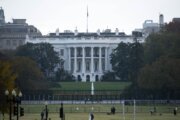NEW YORK (AP) — This Thanksgiving, solar storms may produce faint auroras across the northern rim of the United States.
Pale auroras may be seen across many northern states Thursday and Friday, but they may be brief and and seeing them will depend on how intense the solar storms get, NOAA meteorologist Mike Bettwy said in an email.
Much of the following states are best positioned for potential auroras: Washington, Montana, the Dakotas, Minnesota, Wisconsin, Michigan and Maine. Northern parts of Idaho, Wyoming, New York, Vermont and New Hampshire may also see auroras.
To spy the spectacle, wait for clear skies to get dark and then go outside, ideally away from bright city lights. Taking a picture with a smartphone camera may also reveal hints of the aurora that aren’t visible to the naked eye.
The sun is currently at the maximum phase of its 11-year cycle, making solar surges and northern lights more frequent. Earlier this week, the sun shot a pulse of high-energy plasma towards Earth.
The active period is expected to last for at least another year, though scientists won’t know when solar activity peaked until months after the fact, according to NASA and the U.S. National Oceanic and Atmospheric Administration.
Experts don’t expect major communication disruptions from this week’s solar storm.
In May, NOAA issued a rare severe geomagnetic storm warning — it was the strongest storm in more than two decades, producing light displays across the Northern Hemisphere. Last month, a powerful solar storm dazzled skygazers far from the Arctic Circle when auroras appeared in unexpected places, including Germany, the United Kingdom, New England and New York City.
—-
The Associated Press Health and Science Department receives support from the Howard Hughes Medical Institute’s Science and Educational Media Group. The AP is solely responsible for all content.
Copyright © 2024 The Associated Press. All rights reserved. This material may not be published, broadcast, written or redistributed.






